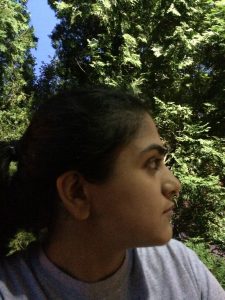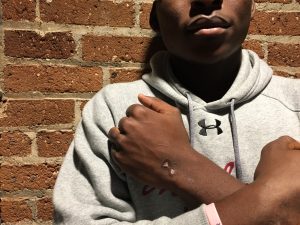Another takeaway from the Kirsten Johnson Q&A is her response to the question that I asked her, “At what point does the one behind the camera have to stop filming and act when there’s (potential) danger about to happen to a subject.” KJ first responds by reminding me that just be being behind the camera that one is already acting. The cameraperson is already intervening and changing the dynamic of things occurring in front of the camera. She spoke about this being a dilemma for ethical people and that one has to negotiate these “second-to-second basis” of what/when to film. She says that we can’t know certain things; therefore, we must constantly seek to understand the people and the environment that we’re in.
Author Archives: Trott Montina
KJ’s short doc, “The Above,”
KJ’s short doc, “The Above,” was interesting in how most of the film’s coverage included a shot of the blimp in nearly every scene. My eyes were drawn to the white surveillance balloon; thus fascinating me to want to find out more about the unknown. The doc presents us with a series of shots taking from different parts of Kabul. At first some might think that they’re just being shown a group of images, but rather each shot setup is revealing information about the surveillance balloon. I like the cinematographic choices when instead of focusing on the actual surveillance balloon, we are shown actual (playful) balloons. I was forced to find a connection between the shots of the surveillance balloon and the playful balloons. When I saw the shot of the green balloon floating around towards the end of the doc, it started to symbolize freedom and happiness. Contrasting that to the surveillance balloon, there is a level of uneasiness that the people are feeling because they feel as though they are being watched.
Kirsten Johnson Q&A Takeaway
One of the key takeaways that I got from the Kirsten’s Q&A is about how to gain trust : One way that KJ is able to gain the trust of the people in her documentary is she gets close to and “see” the “specific” individual. She states, “It doesn’t matter what kind of camera you are using, it matters how you are present with people.” KJ says that camera work is about moving around and that depending on where the cameraperson positions his/herself to his subjects will determine the relationship between them. She moves around with the camera because “there is a compression of time”; thus, she wants those in front of it to know that she is present.
Kirsten Johnson (Key terms/phrases)
The key terms/phrases that stood out to me from reading Kirsten Johnson’s Director Statement were ‘total attention’ and ‘impact reputation.’. ‘Total attention’ stood out to me because it emphasizes the importance of being fully committed to the documentary–that each part of the process demands our undivided focus. ‘Impact reputation’ stood out to me because it reminded me that the work of the person holding (or in control of) the camera is very serious work. The way the camera shoots its subject will have an impact on how viewers perceive/interact with them. Therefore, the cameraperson (or documentarian) has a responsibility to work hard to represent its subject justly.
LV Stories Choice(s)
Number 1, “Borders of Belonging,” is one of my choices for a film I would work on. Over the recent years the Lehigh Valley’s population has been increasing. There is a wealth of diversity of Spanish-speaking immigrants from Central and South America and the Caribbean; as well as, Mexicans, Dominicans, and Venezuelans. It would be interesting to understand the migration and immigration of Hispanic and Latinx communities of the Lehigh Valleh because they are a big part in the population. Also, trying to understand the pros and cons of the migrations and immigrations.
Number 18, “Life in the Valley,” is another film idea that I’d like to work on. I’d like to work on a documentary that is about identifying the Lehigh Valley’s culture—fashion, music, food, language is appealing because: 1) it would be an opportunity to learn about and experience these topics firsthand because I’m not familiar with them and 2) the film idea is doable–it could also be an opportunity for people and businesses to advertise themselves.
IN CLASS FIRST WEEK ASSIGNMENT
My name is Nely and I am from Trenton, New Jersey. I am a junior at Muhlenberg College. I am majoring in Media and Communications and Sociology. My partner for this class assignment was Shreya. She is from Morocco and has two siblings (one sister, one brother). Shreya is also a Junior at Lafayette College studying Film and Economics. At Lafayette, Shreya is Vice President of student government and French language proctor/tutor. Shreya is fond of nature; thus that is why we decided to have her take a picture in the midst of trees. Shreya took a picture of both my wrist. My right wrist has a “Play 4 The Cure In-F-C-R” bracelet. My left wrist contains a fairly fresh scar. Due to my competitive nature, especially in sports, I’m constantly prone to some bumps and bruises.


30-Minute Framing Exercise
For the framing assignment, I made my frame out of an index card (the size of the frame was the size of an Apple charging cube. I chose to make my frame small because I wanted to get a smaller perspective of my environment. Having such a small frame, I could only use one eye to see through it, which means that I was squinting a lot. Ayana and I, walked down 22nd Chew Street, past the Farmer’s Market and into some other areas. The 30-minute walk with the frame was a new experience because I was being forced to see the world from a new view. I couldn’t see my environment in full view, but rather in bits and pieces. However, it was interesting to still be able to decipher the things in my location because of the universal usage of certain symbols; such as, the stop sign. Also, seeing my surrounding through small frame forced me to slow my pace of walking. It took much a longer to register with my surrounding because I had to adjust looking into the frame. I had to look at all corners of the frame and move my head in more degrees than normal to be able to process what I was seeing.
My Disciplinary Perspective
My major is Media and Communications and Sociology. More so, Sociology has been the academic lens through which I form my perspective of the world. Because of the sociological imagination, I am able to stop and think more about my life (and those around me) in relation to the intersection of the larger forces of social life. Thus, I see the world as interconnected parts. All in all, Sociology as open my perspective to seeing the world around me beyond the surface level and to question things to understand why things are the way they are. With this perspective, I want to highlight issues of race and its effects. Using documentary will be useful in representing race issues by bringing them to the public’s eyes. Since documentary aims to represent the truth, it would be a medium that aids in my objective to uncover the underlying truths of society in regards to race. If I were to tell a story of a specific place in the Lehigh Valley it would be in the Allentown community. I would tell a story about Allentown because there is still much that I don’t know about the community that I live in while attending Muhlenberg. Furthermore, when I came into Muhlenberg, there were these negative notions about the community that hindered others and me away. I want to tell a story that combats the negative notions; thus, highlighting the community of Allentown as no different from other places.
Me as a Documentarian
I, as a documentarian, try to document the things around me that I find intriguing. For example, as a visual artist, I like doing works of art that deal with realism. In realism, I try to represent my subject matter as truthfully as I can. Trying to capture a subtle emotion or a mood in my works of art is what I seek to document. When I document those subtle emotions or mood, I like to share it with others to see what reactions my work of art elicits. I appreciate the emotions that my art draws out of people because they are able to take the time to see and ponder about the subtle realities that we overlook.
